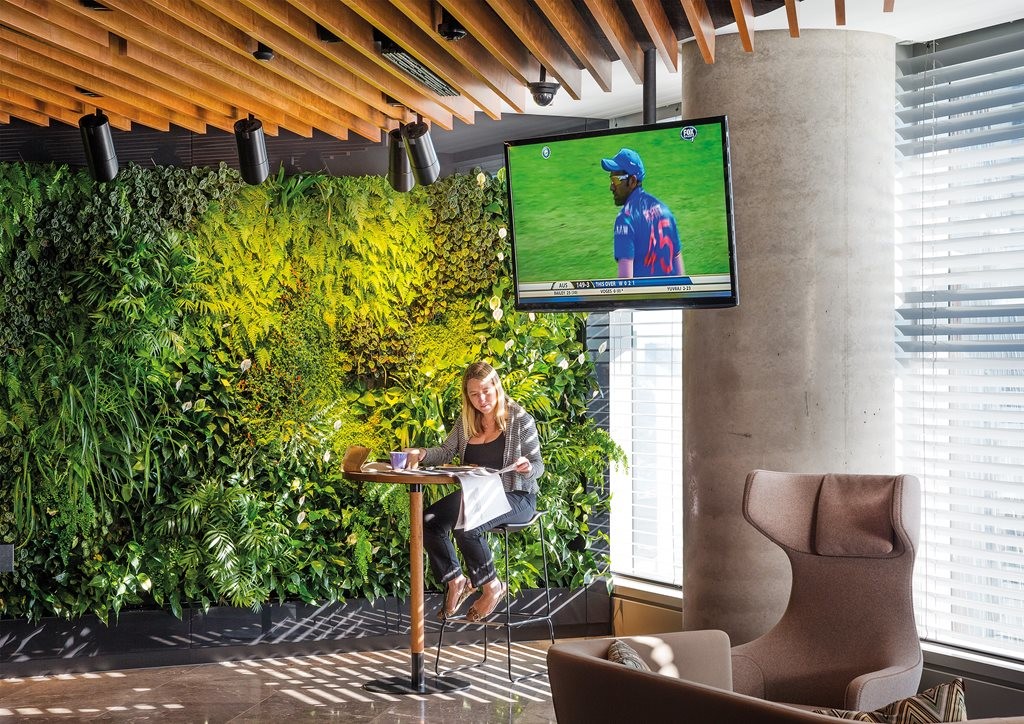A recent study from a University of Queensland’s School of Psychology professor concludes that an office enriched with plants makes staff happier and boosts productivity by 15 per cent.
Those familiar with the theory of ‘biophilia’, which contends that human health and well-being has a biologically based need to affiliate with nature, wouldn’t find these results all that surprising.
As the benefits of natural daylight, ventilation and green space is continually proven to improve productivity and reduce sick days in office workers, building designers are becoming increasingly aware of providing healthy environments for workers through biophilic design.
One recent and self-professed example of biophilic design is the University of Florida Clinical Translational Research Building by US-based Perkins+Will, which is also the firm’s first carbon neutral building.

The design seeks to re-connect the built environment with nature through specific strategies and attempts to incorporate the environmental forces of the site, which includes wetlands, wooded gardens, a parking structure and a cogeneration plant.
The building is sustainable in terms of its carbon footprint, but goes further by incorporating nature into the fabric of the building to create not just an energy efficient building but also happy and efficient workers.

“Understanding the environmental forces of the site, as well as the surrounding context which includes wetlands, wooded gardens, a parking structure and a cogeneration plant, informed the programmatic organization, massing and site strategies,” said the practice.
“The concept emerged from the desire to provide sustainable healing, working and educational environments.”

Biophilic architecture, the concept of healthy sustainable architecture, is a combined study by professors of architecture in Denmark, Sweden and Iraq, and details how biophilic considered design can improve a building’s temperature performance, not just the comfort of its inhabitants.
“Heat management on different building components is the most effective assess for energy efficiency. Passive biophilic architecture has need of a compact system of insulations, which guarantees for both low heat losses and a high level of thermal comfort,” it says.
“Every building needs a building envelope with a ground floor, exterior walls and roofs; the passive biophilic architecture focuses on extreme improvements to these building components high quality heat insulation is thus supplementary.”
The paper concludes that biophilic architecture can provide important environmental and human health benefits which cover a large area of advantages and even includes the amelioration of the urban island effect and relieving the damage on the ecology of the city.
“Green building elements provide important environmental and human health benefits which cover a large area of advantage and benefits that can be for example in ameliorate the urban island effect and relieving the damage on the ecology of the city, principally concerning microclimate, rainwater retention and filtering of airborne pollutant lowering energy expenditures, purifying the air, reducing storm-water runoff, longer durability of the roof skin, due to lower surface temperatures and better protection against UV-radiation, creation of recreation areas in parts of the city, aesthetical improvements in denaturalized urban centres and many others.”
The paper also suggests, like the study by University of Queensland’s School of Psychology professor, Alex Haslam, that green elements, including potted plants and living facades and roofs, provide a more efficient working environment.
“This form of green elements increases the value of the property and the marketability of the building.”
“Psychosomatic researches have shown that the restorative effect of natural view holds the viewer’s concentration, diverts their awareness away from themselves and from worrying thoughts thereby improving health.”

Haslam has sounded similar assertions, stating:
“Office landscaping helps the workplace become a more enjoyable, comfortable and profitable place to be,” he said.
“It appears that in part this is because a green office communicates to employees that their employer cares about them and their welfare.
“Employees from previously lean office environments experienced increased levels of happiness, resulting in a more effective workplace.”
Biophilic architecture has been incorporated in Australian projects; BVN Donovan Hill used it to a degree in their award winning redesign of international law firm Herbert Smith Freehill’s Sydney office (pictured above) by incorporating five greenwalls throughout the offices. Image: John Gollings.
The University of Florida Clinical Translational Research Building by Perkins+Will is an exemplar of biophilic architecture and in achieving carbon neutrality demonstrates that environmentally conscious design doesn’t necessarily stop at the building’s sustainability performance.

